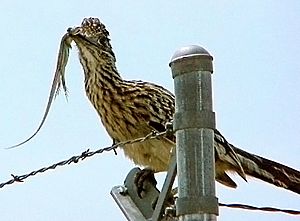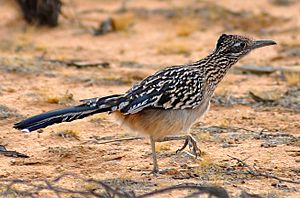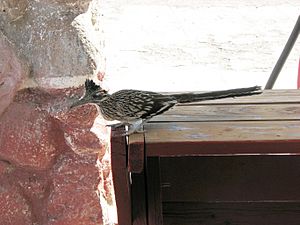Roadrunner facts for kids
Quick facts for kids Roadrunner |
|
|---|---|
 |
|
| Scientific classification | |
| Kingdom: | |
| Phylum: | |
| Class: | |
| Order: | |
| Family: | |
| Subfamily: | |
| Genus: |
Geococcyx
|

The roadrunner (scientific name: Geococcyx) is a super-fast bird known for running on the ground! People also call it the "chaparral bird" or "chaparral cock" because of where it lives. It's a type of cuckoo bird, but unlike many cuckoos, roadrunners spend most of their time on land.
Contents
What Kinds of Roadrunners Are There?
Roadrunners are a special group of ground-dwelling cuckoos. There are two main types, or species:
- The greater roadrunner (Geococcyx californianus)
- The lesser roadrunner (Geococcyx velox)
The greater roadrunner lives in Mexico and the southwestern U.S.A.. The lesser roadrunner can be found in Mexico and Central America.
What Does a Roadrunner Look Like?
Roadrunners are large, thin birds with black-brown and white stripes. They usually weigh between 8 to 15 ounces, which is about as much as a can of soda. From their beak to their tail, they are about 18 to 22 inches (46 to 56 cm) long.
They have:
- Long legs
- Strong feet
- A big, dark beak
Even though they can fly, roadrunners spend most of their time on the ground. When they do fly, their wings are short and rounded, with a white crescent shape on the feathers. Like other cuckoos, roadrunners have special feet called zygodactyl feet. This means they have two toes pointing forward and two toes pointing backward, which helps them grip branches or run fast. Roadrunners can run super fast, up to 20 miles per hour (32 km per hour)! They often fly only when they need to escape from animals that might try to hunt them.
Where Do Roadrunners Live?
Roadrunners live in the dry, open areas called deserts. You can find them in the southwestern U.S.A., Mexico, and Central America. They like places with scattered bushes and cacti.
What Do Roadrunners Eat?
Roadrunners are omnivores, which means they eat both meat and plants. They are excellent hunters!
Their diet includes:
- Insects: Such as grasshoppers, crickets, beetles, and caterpillars.
- Small animals: Like lizards, snakes, rodents, and other small mammals.
- Spiders and other creepy crawlies: Including tarantulas, scorpions, centipedes, and snails.
- Birds and eggs: Sometimes they will eat small birds or their eggs.
- Plants: They also eat fruits and seeds from plants like prickly pear cactus and sumac.
Roadrunners find most of their food by searching on the ground. They usually chase after their prey, but sometimes they might jump to catch flying insects. Because they are so fast, roadrunners are one of the few animals that can hunt and eat a rattlesnake. They are also the only known predator of the tarantula hawk, a large wasp.
Roadrunner Nests and Eggs
Roadrunners build their nests mostly from sticks. Sometimes they add leaves and even pieces of snake skin! A nest usually holds 2 to 6 white-colored eggs.
Both parent roadrunners help take care of the nest and feed their babies, called hatchlings. The male roadrunner usually watches the nest at night, and the female takes over during the day. For the first 1 to 2 weeks after the eggs hatch, one parent always stays at the nest to protect the young. Once the hatchlings are about 2 to 3 weeks old, they leave the nest and do not return.
Images for kids
See also
 In Spanish: Correcaminos para niños
In Spanish: Correcaminos para niños



